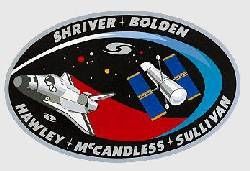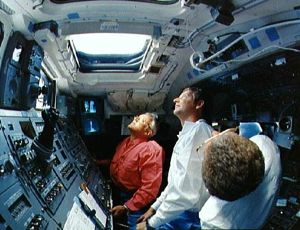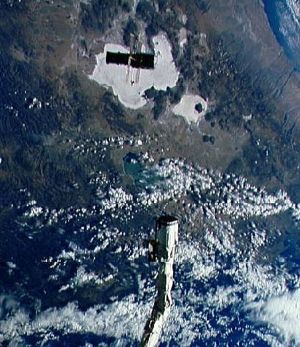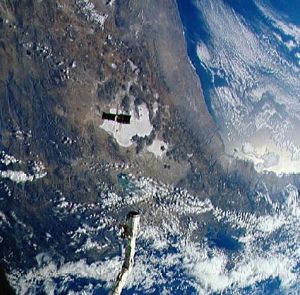
Home - Search - Browse - Alphabetic Index: 0- 1- 2- 3- 4- 5- 6- 7- 8- 9
A- B- C- D- E- F- G- H- I- J- K- L- M- N- O- P- Q- R- S- T- U- V- W- X- Y- Z
STS-31

STS-31
STS-31 Discovery, Orbiter Vehicle (OV) 103, lifts off from KSC LC Pad 39B
Credit: NASA
AKA: Discovery;HST. Launched: 1990-04-24. Returned: 1990-04-29. Number crew: 5 . Duration: 5.05 days.
Payloads: Deployment of Hubble Space Telescope, IMAX camera in payload bay and in crew compartment, Protein Crystal Growth III-03, Investigation Into Polymer Membrane Processing- 01, Air Force Maui Optical Site-05, Radiation Monitoring Equipment III-01, Student Experiment 82-16, and Ascent Particle Monitor 01.
Orbits of Earth: 76. Distance traveled: 3,328,466 km. Orbiter Liftoff Mass: 112,993 kg. Orbiter Mass at Landing: 85,780 kg. Payload to Orbit: 13,005 kg. Payload Returned: 2,162 kg. Landed at: Concrete runway 22 at Edwards Air Force Base, Cali. Landing Speed: 328 kph. Touchdown miss distance: 393 m. Landing Rollout: 2,704 m.
NASA Official Mission Narrative
Mission Name: STS-31 (35)
DISCOVERY (10)
Pad 39-B (14)
35th Shuttle mission
10th Flight OV-103
Crew:
Loren J. Shriver (2), Commander
Charles F. Bolden, Jr. (2), Pilot
Steven A. Hawley (3), Mission Specialist 1
Bruce McCandless II (2), Mission Specialist 2
Kathryn D. Sullivan (2), Mission Specialist 3
Milestones:
OPF - Dec. 5, 1989
VAB - March 5, 1990
PAD - March 15, 1990
Payload:
HST,IMAX-04,APM-01
Mission Objectives:
Launch:
April 24, 1990, 8:33:51 a.m, EDT. Launch scheduled for April 18, then April 12, then April 10, following Flight Readiness Review (FRR). First time date set at FRR was earlier than that shown on previous planning schedules. Launch April 10 scrubbed at T-4 minutes due to faulty valve in auxiliary power unit (APU) number one. APU replaced and payload batteries recharged. Countdown briefly halted at T-31 seconds when computer software failed to shut down a fuel valve line on ground support equipment. Engineers ordered valve to shut and countdown continued. Launch Weight: 249,109 lbs.
Orbit:
Altitude: 330nm
Inclination: 28.45 degrees
Orbits: 80
Duration: 5 days, 1 hour, 16 minutes, 6 seconds.
Distance: 2,068,213 miles
Hardware:
SRB: BI-037
SRM: 360Q/W010
ET : 34/LWT-27
MLP : 2
SSME-1: SN-2011
SSME-2: SN-2031
SSME-3: SN-2107
Landing:
April 29, 1990, 6:49:57 a.m. PDT, Runway 22, Edwards Air Force Base, Calif. Rollout distance: 8,874 feet. Rollout time: 61 seconds. First use of carbon brakes at landing. Orbiter returned to KSC on May 7,1990. Landing Weight: 189,118 lbs.
Mission Highlights:
Primary payload, Hubble Space Telescope, deployed in a 380- statute-mile orbit. Secondary payloads: IMAX Cargo Bay Camera (ICBC) to document operations outside crew cabin and hand-held IMAX camera for use inside crew cabin; Ascent Particle Monitor (APM) to detect particulate matter in payload bay; Protein Crystal Growth (PCG) to provide data on growing protein crystals in microgravity; Radiation Monitoring Equipment III (RME III) to measure gamma ray levels in crew cabin; Investigations into Polymer Membrane Processing (IPMP) to determine porosity control in microgravity environment; Shuttle Student involvement program (SSIP) experiment to study effects of near-weightlessness on electrical arcs, and Air Force Maui Optical Site (AMOS) experiment.
More at: STS-31.
Family: Manned spaceflight. People: Bolden, Hawley, McCandless, Shriver, Sullivan. Country: USA. Spacecraft: Discovery. Projects: STS. Launch Sites: Cape Canaveral. Agency: NASA, NASA Houston.
 | STS-31 Credit: www.spacefacts.de |
 | STS-31 STS-31 crew monitors Hubble Space Telescope (HST) from OV-103's flight deck Credit: NASA |
 | STS-31 STS-31 MS Sullivan wearing EMU prepares for contingency EVA in OV-103 airlock Credit: NASA |
 | STS-31 STS-31 Mission Specialist (MS) Sullivan dons EMU in OV-103's airlock Credit: NASA |
 | STS-31 Hubble Space Telescope (HST) above OV-103's PLB during STS-31 deployment Credit: NASA |
 | STS-31 Hubble Space Telescope Deploy, Eastern Cuba, Haiti Credit: NASA |
 | STS-31 STS-31 Hubble Space Telescope (HST) (SA & HGA deployed) is grappled by RMS Credit: NASA |
 | STS-31 STS-31 Hubble Space Telescope (HST) drifts away from OV-103's RMS Credit: NASA |
 | STS-31 STS-31 Hubble Space Telescope (HST) is released by RMS over Andes Mountains Credit: NASA |
 | STS-31 Sun glint and Florida Peninsula, USA Credit: NASA |
 | STS-31 Thunderstorm, Texas Gulf Coast, USA Credit: NASA |
 | STS-31 Eastern Egypt, Red Sea and Saudi Arabia Credit: NASA |
 | STS-31 West Coast, United States and Mexico Credit: NASA |
1990 April 24 - . 12:33 GMT - . Launch Site: Cape Canaveral. Launch Complex: Cape Canaveral LC39B. Launch Platform: MLP2. LV Family: Shuttle. Launch Vehicle: Space Shuttle.
- STS-31 - .
Call Sign: Discovery. Crew: Bolden,
Hawley,
McCandless,
Shriver,
Sullivan.
Payload: Discovery F10 / Hubble Space Telescope. Mass: 13,005 kg (28,671 lb). Nation: USA.
Related Persons: Bolden,
Hawley,
McCandless,
Shriver,
Sullivan.
Agency: NASA Houston.
Program: STS.
Class: Manned.
Type: Manned spaceplane. Flight: STS-31.
Spacecraft Bus: Shuttle.
Spacecraft: Discovery.
Duration: 5.05 days. Decay Date: 1990-04-29 . USAF Sat Cat: 20579 . COSPAR: 1990-037A. Apogee: 615 km (382 mi). Perigee: 585 km (363 mi). Inclination: 28.50 deg. Period: 96.70 min.
Deployed HST (Hubble Space Telescope). Payloads: Deployment of Hubble Space Telescope, IMAX camera in payload bay and in crew compartment, Protein Crystal Growth III-03, Investigation Into Polymer Membrane Process-ing- 01, Air Force Maui Optical Site-05, Radiation Monitoring Equipment III-01, Student Experiment 82-16, and Ascent Particle Monitor 01.
1990 April 25 - .
- STS-31 - Wakeup Song: Space is Our World - . Flight: STS-31. "Space is Our World" an original song written by the Houston band Private Numbers.
1990 April 26 - .
- STS-31 - Wakeup Song: Shout - . Flight: STS-31. "Shout" by Otis Day and the Knights from the soundtrack of the movie"Animal House".
1990 April 27 - .
- STS-31 - Wakeup Song: Kokomo - . Flight: STS-31. "Kokomo" by Beach Boys CAPCOM: Kathryn Thornton.
1990 April 28 - .
- STS-31 - Wakeup Song: Cosmos - . Flight: STS-31. "Cosmos" by Frank Hays on album"Don't Ask" in honor of Hubble Telescope CAPCOM: Kathryn Thornton.
1990 April 29 - .
- STS-31 - Wakeup Song: Rise and Shine - . Flight: STS-31. "Rise and Shine" by Raffi with Ken Whiteley CAPCOM: Kathryn Thornton.
1990 April 29 - .
- Landing of STS-31 - . Return Crew: Bolden, Hawley, McCandless, Shriver, Sullivan. Nation: USA. Related Persons: Bolden, Hawley, McCandless, Shriver, Sullivan. Flight: STS-31. STS-31 landed at 13:44 GMT. .
Back to top of page
Home - Search - Browse - Alphabetic Index: 0- 1- 2- 3- 4- 5- 6- 7- 8- 9
A- B- C- D- E- F- G- H- I- J- K- L- M- N- O- P- Q- R- S- T- U- V- W- X- Y- Z
© 1997-2019 Mark Wade - Contact
© / Conditions for Use